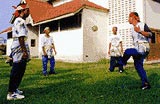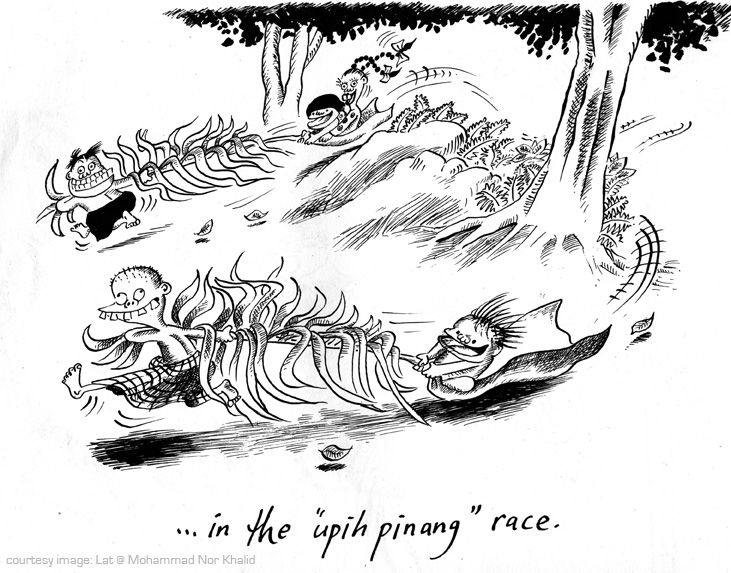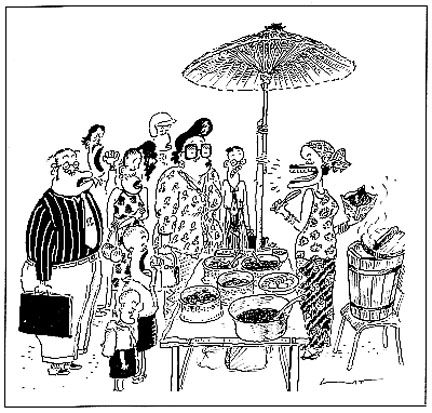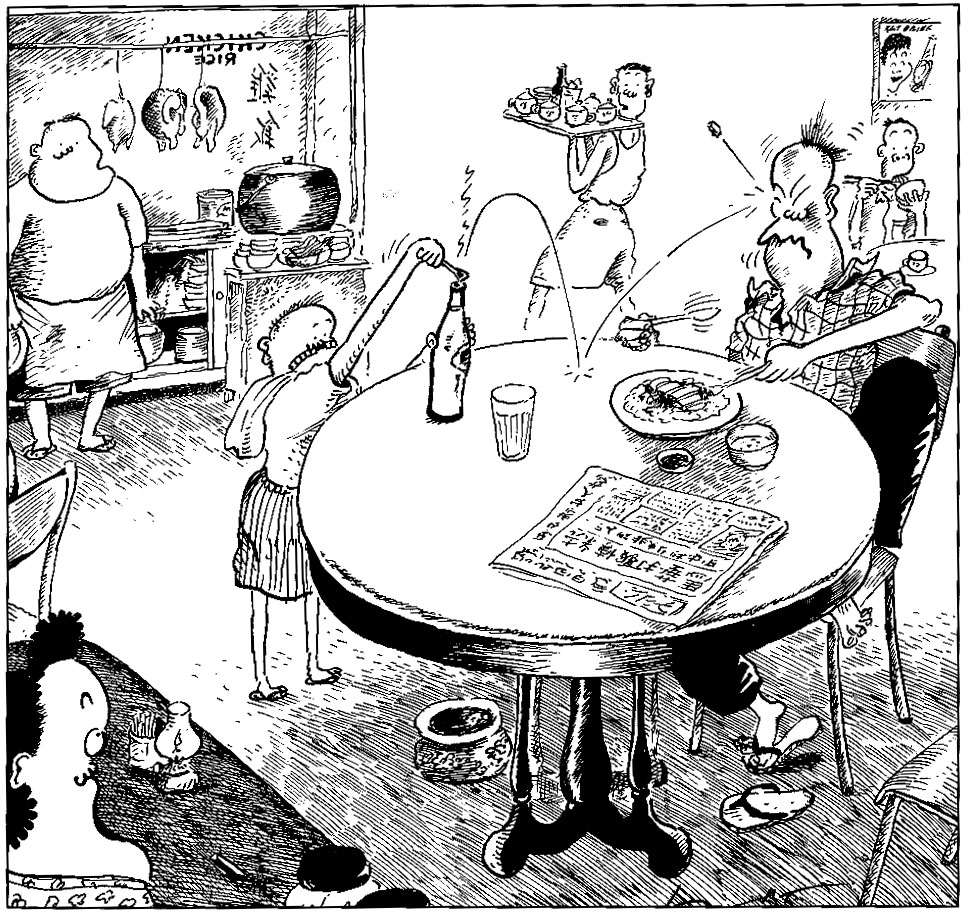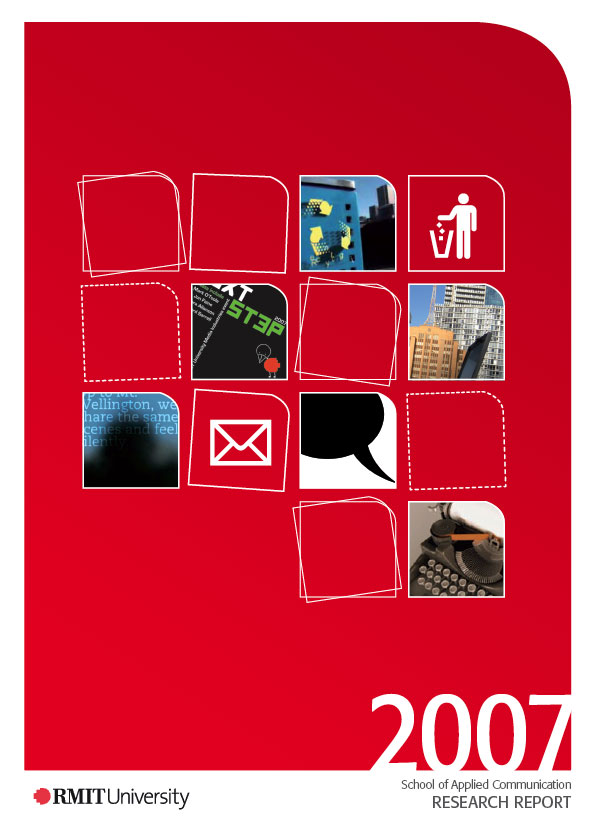Kite or Wau is a intricate floral cutouts are pasted on, building up the design until the kite is ready for the bright paper tassels that complete its decoration. Kite construction is an ancient art passed down from the nobles of the Melakan court. Over the dried padi fields, a wau bulan, or moon kite, catches an upcurrent of air. Its wing span is larger than that of an albatross. What used to be a post-harvest diversion among padi farmers has become an international event. Wau festivals are organized each year and draw participants from as far away as the Netherlands, Japan, Germany, Belgium, and Singapore.The pre-harvest counterpart to the post-harvest wau-flying is top-spinning, a game requiring great strength, excellent timing, and dexterity. These are not childrens’ toys.
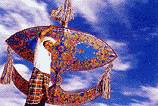
Gasing, or spinning top, can weigh up to ten pounds and can sometimes be as large as a dinner plate. Gasing competitions are judged by the length of time each top spins. The tops are set spinning by unfurling a rope that has been wound about the top. A gasing expert can set one spinning for over an hour. It calls for strength, coordination, and skill. The gasing, if expertly hurled, can spin for as long as 2 hours. Top spinning competitions are an annual feature in the east coast of Peninsular Malaysia especially Kelantan and Terengganu.
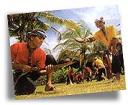
Childhood
Childhood and space
When I was a kid, when the school holidays started, my parent will take me to my grandparent’s place which situated in Kedah, the northern state in Malaysia. Mainly in Kedah it is kind of rural compare to Penang which is very much city like. The best things being in rural areas ‘kampung’ is the space, and its not only empty space but with trees and some ‘kampung’ insects (e.g.butterflies, dragonflies etc.) and animal like rural chicken ‘ayam kampung’ etc.
At that time there are no internet or broadband. As a kid, having the big space to explore means a lot of work do. Further more, having cousins around makes it much more adventurous. Many ideas is much better than one. We start with discussion about what we wanted to do. Having a space triggers several creative thoughts. Using object around us and perhaps some from the house (borrowed from my grandmother) will help to make something. What should we do with this space? Should we make hut out of the tree and leaves (mainly we use coconut leaves because it’s big) ? Or make some color from organic product? Or make some chairs for us to sit under the trees? We end up making so much things, and this process always make us wanted to go back to the space we have in the ‘kampung’.
Why when we as a kid, when we can’t consume much, we allowed ourselves to think creatively using space and object we have around us just to have some excitement? What allow us?
‘Tarik upih’ is one of the game that I played with my parent and my uncle. ‘Upih’ is from coconut leave, old and dry, then I sit on the leave, my uncle pull it and run with me on it. We make a race with my parent and we had so much fun. It use our energy too.
Branding without branding
I was talking to Areli today discussing about my research proposal and there is some issues that interest me from this interesting discussion. Well, in my Phd research I want to explore the role of communication designer in market world such as branding, and marketing. I know the role of communication designer is more that doing design and try to create an identity or making things look better in selling or product creation. So I really hope in this research I will be able to identify what is actually the main role of communication designer. I know it is the question that every designer ask, and it’s still i guess, is good to ask.
What is branding without branding?
Natural things, animal do it, fruit do it…can we actully do it with product?
What if, in my research, using my skill and knowledge as a communication designer to improve the making of the traditional/local product by consulting the design of the strategy, packaging, layout, promotions, identity, image and things that relate to improve the product. And using a branding strategy and method to develope and to improve the product, without branding the product or in other words, changing the ‘brand’ of the product.
Is this process still recognise as ‘re-branding’ or part of branding process?
I think I’m lost again…just as soon as I think I’m back on the track!
No News Mean Good News?
I haven’t been writing much lately…i guess since two weeks ago, that I actually stop writing my blog, or putting some input in the blog. For some reason, I’m scared to write…writing is a responsibility, for me personally…so I stop and I spend my time thinking which I think still doesn’t help at all. For the last two weeks I’m struggling trying to prepare my proposal, which I finally manage to do it. In my proposal, I started to see some of the ideas that i think relevant to my research.
In my Phd research, I’m interested in the process of design and branding and culture evolve. How can a communication designer, help to improve the local traditional product to become global/or in the market wave? What is the role of communication designer in this process that related to branding, design and culture?
GRC(Graduate Research Conference) is coming soon, and this will be my first time presenting my idea to other people. What are my key questions that can guide me in this research? What is the image I have in my mind, when I think about this research? Why is this research is so important for me? Why did I want to do this research?
Sometimes I just don’t know why I want to do this research, and sometimes, I really want to make a different..and sometimes I just lost..in my questions..But somehow I know by doing this research practice, I will find my self and why I’m doing this..Till then..
Cultural Identity
Brand and Branding
by Robert L.Peters, published on November 14, 2005.
Branding, as in the marking of livestock by means of a burning iron, has been practiced for at least 5,000 years. “Brands” and “branding” are all the buzz today, particularly in North America and the corporate world run by MBA graduates. Brands have been variously defined as “an indelible impression,” “a gut feeling or understanding about a product, service, or company,” and “a user promise,” to list but a few “ they typically involve symbolic attributes, and as such, they are also vulnerable to fashion.
Many consultants swear by brands and brand management “ others swear at the word, seeing it as the latest term de jour of the marketing world and a “shallow hyper-moniker” that overstates its promise (perhaps to compensate for the surface traits the word brings to mind). The foundation of a brand is a trust relationship, reinforced when positive experience consistently meets or exceeds expectations. Brands can also act as ‘noms de guerre’ or ‘pseudonyms’ for less recognizable corporate origins, though in most cases brands imply a product-based relationship.
In an increasingly virtual world, “brand equity” can grow to become one of an organization’s greatest assets, often providing the best return on investment “ Coca-Cola’s brand value alone has been pegged at USD $70 billion, representing more than 60 percent of the giant corporation’s market capitalization.
Questions:
Brand..is it a myth or a living ‘monster’?
How do we as a designer, fill the needs of the social contexts? What are our contribution?
Culture is by nature complex as some parts are subject to fashions and trends; the rest, the core part, is less flexible. Culture encompasses language, traditions, beliefs, morals, laws, social behaviors and the arts of community. Identity lies at the very core of culture and it is the key to our understanding of self. Understanding the culture is imperative in avoiding identity crisis and rootless, and its a perquisite for the effective shaping the identities and communication.
Aesthetically, culture operates globally as a signifier of differences and similarities in taste and status within groups. Anthropologically, culture refers to how we live our lives, often between social groups or populations.
Designing in a Social Contexts
Brand and Branding
by Robert L.Peters, published on November 14, 2005.
Branding, as in the marking of livestock by means of a burning iron, has been practiced for at least 5,000 years. “Brands” and “branding” are all the buzz today, particularly in North America and the corporate world run by MBA graduates. Brands have been variously defined as “an indelible impression,” “a gut feeling or understanding about a product, service, or company,” and “a user promise,” to list but a few “ they typically involve symbolic attributes, and as such, they are also vulnerable to fashion.
Many consultants swear by brands and brand management “ others swear at the word, seeing it as the latest term de jour of the marketing world and a “shallow hyper-moniker” that overstates its promise (perhaps to compensate for the surface traits the word brings to mind). The foundation of a brand is a trust relationship, reinforced when positive experience consistently meets or exceeds expectations. Brands can also act as ‘noms de guerre’ or ‘pseudonyms’ for less recognizable corporate origins, though in most cases brands imply a product-based relationship.
In an increasingly virtual world, “brand equity” can grow to become one of an organization’s greatest assets, often providing the best return on investment “ Coca-Cola’s brand value alone has been pegged at USD $70 billion, representing more than 60 percent of the giant corporation’s market capitalization.
Questions:
Brand..is it a myth or a living ‘monster’?
How do we as a designer, fill the needs of the social contexts? What are our contribution?
Brand and branding
Brand and Branding
by Robert L.Peters, published on November 14, 2005.
Branding, as in the marking of livestock by means of a burning iron, has been practiced for at least 5,000 years. “Brands” and “branding” are all the buzz today, particularly in North America and the corporate world run by MBA graduates. Brands have been variously defined as “an indelible impression,” “a gut feeling or understanding about a product, service, or company,” and “a user promise,” to list but a few “ they typically involve symbolic attributes, and as such, they are also vulnerable to fashion.
Many consultants swear by brands and brand management “ others swear at the word, seeing it as the latest term de jour of the marketing world and a “shallow hyper-moniker” that overstates its promise (perhaps to compensate for the surface traits the word brings to mind). The foundation of a brand is a trust relationship, reinforced when positive experience consistently meets or exceeds expectations. Brands can also act as ‘noms de guerre’ or ‘pseudonyms’ for less recognizable corporate origins, though in most cases brands imply a product-based relationship.
In an increasingly virtual world, “brand equity” can grow to become one of an organization’s greatest assets, often providing the best return on investment “ Coca-Cola’s brand value alone has been pegged at USD $70 billion, representing more than 60 percent of the giant corporation’s market capitalization.
Questions:
Brand..is it a myth or a living ‘monster’?
Entrepreneurship
What is Entrepreneurship?
This words was born recently and now it has been use widely around the world expecially in US culture as being a critical component of its capitalistic society. Is entreprenuer is another word for branding. Its in bussiness world and the main mission is to gain profit.
Defining entrepreneur
An entrepreneur is someone who organizes a system to create a product or service in order to gain profit. However though there is a general sense that entrepreneurship involves the establishment of a new venture while adopting some of the risk, there is no common definition as the word has been used many ways in many times. Some scholars of entrepreneurship, such Prof. W. Long have tried to develop a definition by looking at the historical use of the word, as it evolved (outcart 2000). Perhaps the first person to create a theory about entrepreneurs would be Schumpeter, although instead of using the French word adopted by the American literature, he used the German word “unternehmer”.
Taken from – http://en.wikipedia.org/wiki/Entrepreneur#Defining_entrepreneur
There are more about being as an entrepreneur, as I will continue later..soon!
Lat & The Kampung Boy
I always love visual. I guess just by looking at an image, our imagination just fly free. Many stories we can tell just from an image. So I try to relates or shows my research through other media such as movie snap shot, cartoons and images. It might help, I guess. I honestly don’t know where is this going. Let’s move to Lat’s story.
I think Lat’s cartoons provides an invaluable guide to Malaysian culture, expressed in a way mere words never could. I still remember that I always looking forward to read Lat’s Cartoon Strip in Malaysian Newspaper called Mingguan Malaysia when I was 14 years old. It’s been recommended to me by my ‘Pak Long’ my uncle. Since then I become Lat’s Fan. It’s only publish once a week, but I always waited for it.
His cartoons depicts everyday scenes of Malaysia. From the bus driver to the Prime Minister. Everybody is included. He also include every race from Malaysia’s multicultural society: the Chinese, the Indians, the Malays to the “Orang Putih” the Europeans. His cartoons are funny and witty, Lat enjoys poking fun at everyday situation and reading them brings back my own memories of growing up in Malaysia. Most of them still makes me laugh out loud! Lat’s cartoon can also be serious with a political or environmental message.
Lat’s early life taken from Lat Cartoon Website
http://www.geocities.com/woo_ben/lat/lat.htm
Lat was born Mohammad Nor bin Khalid in March 1951, in a kampung (village) house in Kota Bahru, Perak, Malaysia. He grew into a chubby little fellow and got a nickname as Bulat, or Lat.
Words from Lat about his life in the kampung (extract from “Lat 30 Years Later”):
“To say my family was a crazy would be an understatement. Growing up in the kampung, I remember being surrounded by family members who seem to have nothing else to do except joke and be merry.
My father was like most fathers in that he would scold us and get angry but he was never all that serious. He was a joker and we learned, from very young, never to take what he said for granted. Even when he sounded serious, he was probably making fun on things.
My mum was the more serious one but even then she had her moments – once she actually went to a photo studio to pose in a saree (Indian dress) with her sister.
Ours was a closely-knit community and the kampung folks were similarly jovial. The way they spoke and ask questions hinted of mischief. I think it was because we were so close that we could have such a relationship. After all, you don’t speak to strangers this way.
Without the distractions of modern living, we had to find out own diversions. One of the first thing we did was to mimic others. I still remember the Chinese grocer name See Han who would speak in a very slow melodious voice. We had a lot of fun mimicking that.
I also remember the ‘Mak ciks’ and ‘Pak ciks’ who would, just by their appearance, make you roll over with laughter. In the 1950s, for instance, when it was fashionable to have rambut karan (saloon perm), watching the kampung women on parade with their hair done up was really hilarious.”
Some of Lat’s cartoon that relates to Malaysian cultures.
Design Folio
Creative Commons Attribution-NonCommercial-NoDerivs 2.5 License.
DESIGNING A RESEARCH REPORT (2007)
End of last year I was asked to design a research report for School of Applied Communication by the Director of Research, Dr. Vaughan. The whole point is to presented the research activities that the school have done in 2007. Also if it’s possible to put some images from the researcher. The task sounds easy and I agree to take. The whole design process included collections of information from all the researcher, collections of images and the design process. We decided to make a from so it will be easier for us to have the information instead of keeping the emails that contained the details. But because the researches life is pretty busy, we need to keep reminding them to fill in the form. And yes, when it comes to the very end, we still receives some changes and new forms. Then we have to fit in all the information in one document and categorize the topics. Later when its ready, Angelo (the administration person who handle the emails and enquires) sent the whole document to me. I then have to transfer the words file to indesign. That’s for the collections process.
Now it comes to design process. I started with a concept and did some brain storming. I discussed with Dr. Vaughan about it and added some other information that they want to be in. We try to standardize the design to RMIT design layout. I make few design mock-up and showed to the member to get some feed back. Came back with pretty much changes. I did few rounds in that steps. Then finally managed to get the final design look that please everybody. The whole project took nearly three weeks time to finish. Here are some of the samples and the full version in PDF.
REDESIGNING SBS ANNUAL REPORT (2005)

There are few design job that I did last year for my Masters in Design by project. The last one is a case study project on SBS annual report. It is more about designing an annual report as a Information Design System.
I’m researching about what people call ’emotional design’ which is from my opinion is not much different than branding (I figure this after the research). Then I tried to find a way of putting ’emotional design’ together with ‘information design’.
Some of the reference I got are from Marc Gobe with his book called Emotional Branding.
“In many, many more words than needed, Marc Gobe makes an argument for using the corporate and product attributes to build a brand. For example, the name. “Lexus” sounds like luxury. “Viagra” suggests vigor and virility.
The Ford Expedition, the Ford Excursion and the Ford Escape are all named with less than subtle ulterior motives.
Use of color may also assist in conveying a desired brand image. Red conveys one thing; blue another. Blue, pink, orange, black – each color is stereotyped with certain personality traits. The shape of the bottle that holds your soft drink; the texture of the paper that brochure is printed on; the font used for the corporate logo; all these things add up to build a brand image.”
Taken from link to reviews of Emotional Branding Book – http://www.v7n.com/emotional-branding.php.
Belows are the brief page:
From this I thought may be I can suggest SBS to come out with a new promotion kit, just for certain season. My idea is for SBS to have a new look, not to replace the look that they are now but just to make a little bit different for a period of time.
So I came out with the theme ‘Turn ON SBS’, this idea came from a discussion with Keith, SBS Promotion Manager in Sydney. He wanted to have something different but still he wanted to use the same content as the old brochure SBS have.
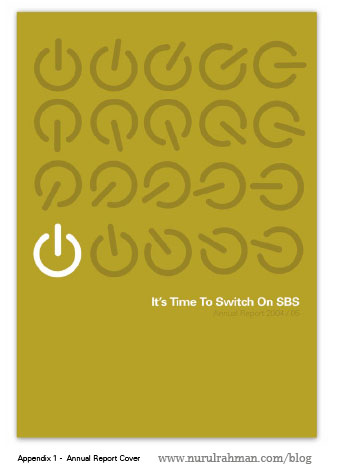

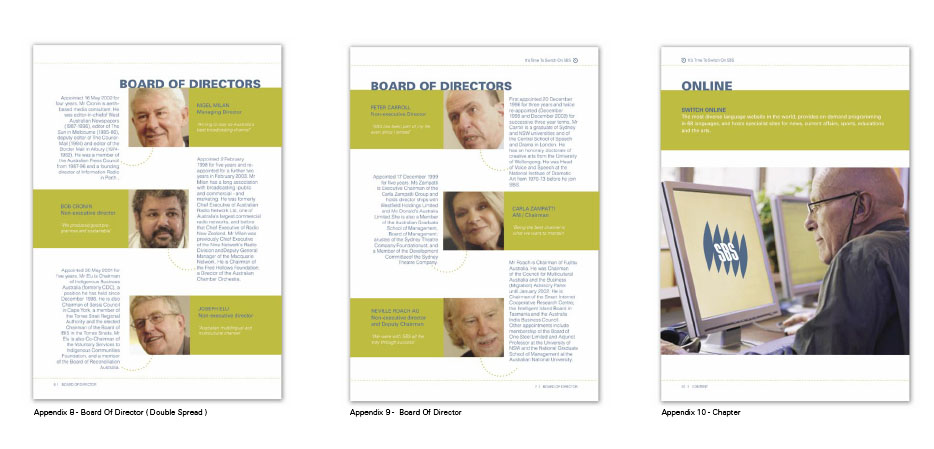
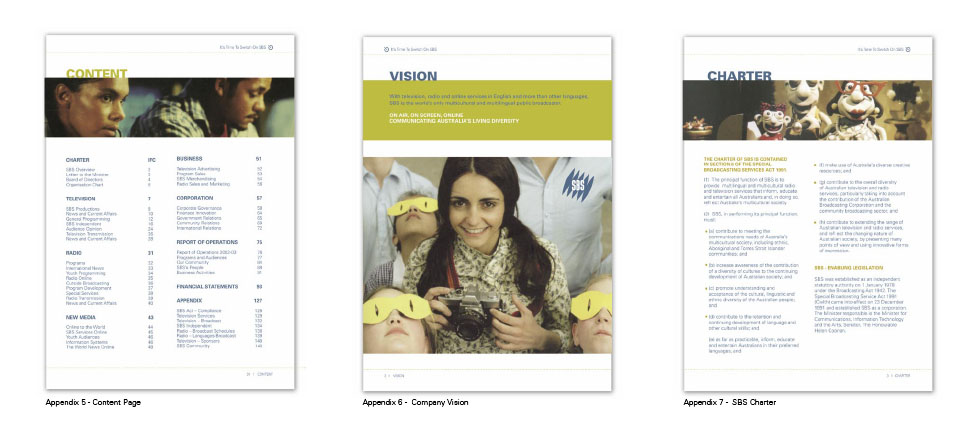
DESIGN AS A SERVICE
In one of my Masters Class we did this exercise to understand the the concepts then visualized it through different layout. We’re designing an event. Under the event umbrella we have to provide the corporate logo, stationary set, brochures and other printed material that we can think of. I choose rock climbing event in Melbourne CBD. I got inspired by the architecture of the Federation Square, modern and challenging structure. I thought it would be a good if we could climb the fed Square.


